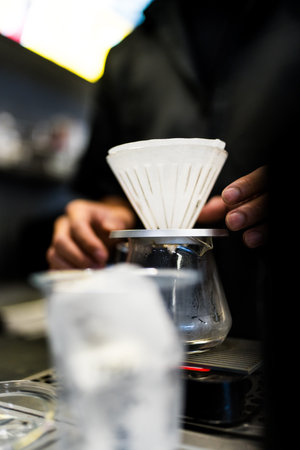1. Why Oat Milk is the Barista’s Plant-Based Choice
In coffee shops across the U.S., oat milk has quickly risen to the top as the go-to dairy alternative for both baristas and customers. But what makes oat milk stand out from other plant-based options like almond, soy, or coconut milk? It all comes down to three main factors: texture, flavor, and sustainability.
Texture That Steams Like a Dream
One of the biggest reasons baristas love oat milk is its ability to steam and froth similarly to whole milk. Its natural creaminess allows it to create that silky microfoam essential for cappuccinos, making latte art more achievable compared to thinner plant-based milks.
Milk Texture Comparison
| Milk Type | Froth Quality | Creaminess |
|---|---|---|
| Oat Milk | Excellent | High |
| Almond Milk | Poor to Fair | Low |
| Soy Milk | Good | Medium |
| Coconut Milk | Fair | Medium-High |
Mild, Balanced Flavor Profile
Unlike some plant-based milks that can overpower or clash with espresso, oat milk has a mild, slightly sweet taste that complements rather than competes with coffee’s natural flavors. Its balanced profile enhances the richness of espresso without masking its notes.
Taste Compatibility with Coffee
| Milk Type | Taste Description | Coffee Compatibility |
|---|---|---|
| Oat Milk | Mild, slightly sweet, creamy | Excellent |
| Almond Milk | Nuttier, sometimes bitter when heated | Poor to Fair |
| Soy Milk | Bean-like flavor, can curdle in acidic coffee | Fair to Good |
| Coconut Milk | Coconut-forward, sweet aftertaste | Fair (can overpower espresso) |
A Sustainable Sip
Sustainability is another major reason oat milk is gaining traction. Compared to dairy and other plant-based milks, oats require less water and land to grow. Plus, oat crops are widely available in North America, making them a more eco-friendly option with a smaller carbon footprint.
Sustainability Snapshot (Per Glass)
| Beverage Type | Water Usage (liters) | Carbon Emissions (g CO₂e) |
|---|---|---|
| Dairy Milk (cow) | 120+ | 500+ |
| Almond Milk | 70+ | 200+ |
| Soy Milk | 28+ | 200+ |
| Oat Milk | <10 | <100 |
The combination of excellent frothing ability, delicious taste, and earth-friendliness makes oat milk an easy favorite among U.S. baristas looking to serve up quality cappuccinos—without compromising on flavor or values.
2. What You’ll Need: Tools and Ingredients
If you want to make a barista-level oat milk cappuccino at home, having the right tools and ingredients is key. Heres what youll need to get started, plus some brand recommendations that are popular in the U.S.
Essential Tools
These are the basic tools you’ll want for crafting your oat milk cappuccino like a pro:
| Tool | Description |
|---|---|
| Espresso Machine | A machine with at least 9 bars of pressure; semi-automatic or fully automatic models work well. Brands like Breville and Gaggia are great for home use. |
| Coffee Grinder | Burr grinders give you consistent espresso grounds. Baratza and Fellow are popular choices. |
| Milk Frothing Pitcher | A stainless steel pitcher (12–20 oz) helps you control the pour and create latte art. |
| Tamper | A flat-bottom tamper ensures even pressure when packing espresso grounds. |
| Thermometer (optional) | Helps you steam oat milk to the ideal temperature (between 130°F–150°F). |
Coffee Beans
Your espresso shot is the heart of your cappuccino, so choose quality beans. Look for medium to dark roast espresso blends with chocolatey or nutty notes—they balance beautifully with oat milk’s natural sweetness. Some U.S.-based roasters to check out:
- Stumptown Coffee Roasters – Hair Bender Blend
- Verve Coffee Roasters – Streetlevel Espresso
- Counter Culture – Big Trouble
The Right Oat Milk
This one matters more than you’d think. Not all oat milks steam the same—some separate or don’t froth well. Baristas love these brands because they’re designed for steaming and taste great in coffee:
| Brand | Description |
|---|---|
| Oatly Barista Edition | Creamy texture, easy to froth, widely available in U.S. grocery stores. |
| Califia Farms Barista Blend | Dairy-free and almond-free option with smooth flavor and good microfoam. |
| MALK Oat Milk | A clean-label choice with minimal ingredients, great for those who prefer organic options. |
Add-On Ingredients (Optional)
If you like a flavored twist or want to sweeten things up, here are a few extras you might enjoy adding:
- Cinnamon or Nutmeg: Sprinkle on top for a warm spice aroma.
- Sugar or Simple Syrup: For added sweetness—go light so it doesn’t overpower the espresso.
- Syrups (Vanilla, Hazelnut, etc.): Use coffee shop-style flavors sparingly to enhance without masking your coffee’s flavor profile.
![]()
3. Steaming Oat Milk Like a Pro
If you want your oat milk cappuccino to taste like it came straight from your favorite local café, mastering the steaming process is key. Unlike dairy milk, oat milk behaves differently under heat and pressure, so it requires some special attention to get that smooth, velvety microfoam every barista aims for.
Why Oat Milk Is Different
Oat milk has less protein than cow’s milk, which means it doesn’t stretch or foam the same way. However, with the right technique and temperature control, you can still create a creamy, rich foam perfect for cappuccinos.
Ideal Steaming Temperature
Keep your steam wand thermometer handy! Overheating oat milk can cause separation or a grainy texture. Heres a quick guide:
| Milk Type | Ideal Temp (°F) | Texture Goal |
|---|---|---|
| Dairy Milk | 150–155°F | Stretchy Microfoam |
| Oat Milk | 130–140°F | Velvety Microfoam |
Step-by-Step: How to Steam Oat Milk
1. Start Cold
Always begin with cold oat milk and a chilled pitcher. This gives you more time to introduce air and texture before the milk heats up.
2. Positioning the Steam Wand
Place the steam wand just below the surface of the milk at a slight angle. This helps draw in small amounts of air to create microfoam without large bubbles.
3. Introduce Air Early On
You only want to “stretch” the oat milk (add air) during the first few seconds. Listen for a gentle hissing sound—not splattering or screeching—which means youre doing it right.
4. Submerge and Swirl
Once youve added enough air (usually after 5–7 seconds), submerge the wand deeper into the milk to create a whirlpool effect. This helps break down any larger bubbles and creates a uniform texture.
5. Stop at 130–140°F
Avoid overheating. Use a thermometer or learn to feel when the pitcher is just too hot to touch comfortably—that’s usually around 135°F.
Troubleshooting Common Issues
| Problem | Cause | Fix |
|---|---|---|
| Bubbly Foam | Too much air introduced or wand too high in milk | Lower wand slightly and reduce stretching time |
| No Foam at All | Wand too deep or not enough air added early on | Start closer to surface and stretch within first few seconds |
| Grainy Texture | Overheated or poor-quality oat milk | Stick to 130–140°F and use barista-formulated oat milk brands like Oatly Barista or Califia Farms Barista Blend |
Nailing your steaming technique takes practice, but once you get the hang of it, youll be able to produce café-quality oat milk cappuccinos in your own kitchen—complete with that luscious microfoam cap everyone loves.
4. Pulling the Perfect Espresso Shot
To create a delicious oat milk cappuccino, you first need to master the espresso shot—its the foundation of your drink. A well-pulled espresso balances sweetness, acidity, and body, creating a rich base that complements the creamy texture of oat milk.
What You’ll Need
| Tool | Purpose |
|---|---|
| Espresso machine | Brews the espresso under pressure |
| Burr grinder | Grinds coffee beans evenly for consistent extraction |
| Tamper | Compresses coffee grounds in the portafilter |
| Scale & timer | Measures dose and shot time accurately |
The Essentials of a Great Espresso Shot
- Fresh Coffee: Use freshly roasted beans within 2-4 weeks of roast date.
- Proper Dose: Aim for 18–20 grams of ground coffee for a double shot.
- Even Tamp: Apply firm, level pressure to avoid uneven extraction.
- Correct Brew Time: Target 25–30 seconds for a balanced shot.
- Yield: A typical double shot should yield about 36–40 grams of espresso.
Troubleshooting Tips
If your espresso tastes sour or watery, try grinding finer or increasing your dose. If it tastes bitter or burnt, grind coarser or reduce your brew time. Heres a quick reference:
| Taste Issue | Likely Cause | Suggested Fix |
|---|---|---|
| Sour or weak | Under-extraction | Grind finer, tamp more firmly, increase brew time slightly |
| Bitter or harsh | Over-extraction | Grind coarser, reduce brew time, check water temperature (195-205°F) |
The Role of Espresso in Oat Milk Cappuccinos
A smooth and robust espresso pairs beautifully with the natural sweetness and creaminess of oat milk. Since oat milk has a mild flavor profile, it won’t overpower your espresso—so nailing this step is key to making your cappuccino shine.
Pro Tip:
If youre using a darker roast for a more traditional taste, consider pulling a shorter shot (a “ristretto”) to avoid overwhelming bitterness when mixed with oat milk.
Once youve mastered your espresso shot, youre ready to move on to steaming your oat milk like a pro. Stay tuned!
5. Assembling the Cappuccino and Nailing the Pour
Now that youve pulled a balanced shot of espresso and steamed your oat milk to perfection, its time to bring everything together. This part is where the magic happens—combining rich espresso with creamy oat milk in the right ratio and finishing it off with a touch of latte art flair.
The Ideal Oat Milk Cappuccino Ratio
When crafting a cappuccino, balance is key. A traditional cappuccino has equal parts espresso, steamed milk, and foam. With oat milk, this balance still applies—but since oat milk tends to be lighter and less dense than dairy, youll want to slightly adjust how you handle the foam.
Standard Cappuccino Ratio
| Component | Volume |
|---|---|
| Espresso | 1 oz (single shot) |
| Steamed Oat Milk | 1 oz |
| Oat Milk Foam | 1 oz |
Pouring Technique: Smooth and Steady Wins
Start by gently swirling your steamed oat milk to integrate the microfoam evenly. Then, tilt your cup slightly and begin pouring slowly from a few inches above the surface. Once your cup is about halfway full, lower the pitcher closer to the cup and increase your pour speed to introduce more foam.
Steps for a Clean Pour:
- Swirl your milk pitcher: Make sure theres no separation between liquid and foam.
- Tilt your cup: Helps control where the milk lands for better integration with espresso.
- Pour slowly at first: Let the heavier liquid integrate under the crema.
- Bring pitcher closer as you go: This helps lay down foam gently on top.
Add Simple Latte Art (Optional but Fun!)
If youre feeling confident, try adding a basic heart or tulip pattern. These designs are easier than you think and give your cappuccino that pro-level finish. Start with a centered pour, then wiggle gently as you pour closer to the surface to create layers or shapes.
Beginner-Friendly Latte Art Tips:
- Use fresh oat milk: Barista-style oat milks froth better for art.
- Aim for microfoam: The smoother the texture, the easier it is to shape patterns.
- Pace yourself: Latte art takes practice—don’t rush!
Your oat milk cappuccino is now complete—with perfectly balanced flavors, smooth texture, and maybe even a little latte art flourish on top. Keep practicing these techniques to turn your home coffee game into something worthy of your favorite neighborhood café.


